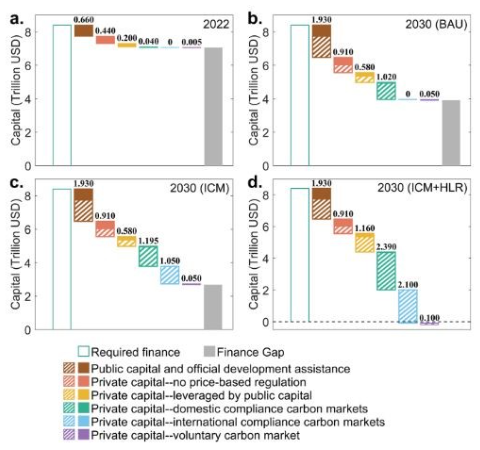Strong emissions trading system prices encourage and facilitate climate action but also reflect private sector confidence in governments’ commitments to long-term transformation.

Every evening in my Brooklyn neighborhood we come out onto our stoops with our children, dogs, bells, horns and pots (my contribution – inspired by the Colombian cacerolazos I witnessed protesting – non-violently, though I can’t say quietly – in Bogotá). We make a big noise to thank and celebrate the generosity and selflessness of the medical personnel and essential workers who are keeping life going during the crisis. Their example is an inspiration to us all and reminds us that humans are at essence a cooperative species. This same spirit of cooperation, backed up by strong social and political institutions including effective emissions trading systems, can help protect our climate in these difficult times.
Our focus now must be on flattening the curve, caring for the sick and vulnerable, and then getting back to work. But as we recover from this crisis, we need to do so in a way that helps us confront the next one: global climate change. Lawmakers in many countries are beginning to pivot from relief to recovery, focusing on the longer-term work of getting the economy back on track. We need that economy to have low greenhouse gas emissions.
No one should take false hope from the temporary decline in greenhouse gas emissions we have seen recently. In the short term, when economic activity falls, pollution falls. During the financial crisis of 2007-9 global greenhouse gas emissions did drop, slightly and briefly. The current economic crisis is deeper but will also pass and when it does, so too will the dip in climate pollution.
To make declines in emissions permanent, we need to seize this moment of fundamental change to ensure effective, efficient, resilient policies to lock in economic and behavioral shifts that do contribute to a transition to a low emission future where all people thrive.
One key element of the policy mix in an increasing number of countries and jurisdictions is an Emissions Trading System. These systems limit greenhouse gas emissions while allowing flexibility around where and when emissions occur. They provide price signals to help guide clean investment and other climate actions. The limit, or cap, controls emissions; the marginal cost of achieving that limit, which depends on technology and other climate policies among other things, drives the ETS price.
What drives emission prices?
Those ETS price signals have been affected by COVID and its economic consequences. The climate challenge is no less urgent, but is the private sector feeling less pressure from governments to act? Are the canaries who sing in the healthy cooperation mine falling quiet?
Initially both the European Union and New Zealand ETS prices dropped dramatically, but they have since clawed back much of their initial losses. Will they recover and even move to levels consistent with modeled estimates of prices required to stabilize the global at less than two degrees above pre-industrial levels? A recent survey by IETA suggests not. It finds private sector expectations of emissions prices over the next 10 years have fallen relative to expectations a year ago by 12% (EU and the Western Climate Initiative (WCI) – California and Quebec), 27% (Regional Greenhouse Gas initiative), and 35 – 38% (New Zealand and Mexico). What does this mean?
During a recession, when capital is scarce, because ETS units are assets their price will also tend to fall in a similar way to other assets. As the financial sector recovers, asset prices should also recover. These price adjustments, like those driven by new information about mitigation technology provide useful signals. However, general economic factors and new information about the true costs of achieving our climate goals are not the only drivers of these changes in prices.
Because an emissions trading system is a market created by regulation, the price in each ETS is deeply dependent on expectations about the future stringency of that regulation. Because allowances in emissions trading systems are ‘bankable’ (they can be saved for future use by those who emit less and hence surrender fewer allowances today), as long as there is a ‘bank’ of units available their price depends on what people expect demand and supply will be in future, not just on current scarcity. That makes ETS prices a barometer of both the stringency of policy that politicians are willing to implement—and also of the private sector’s expectations about how stringent policy is likely to be over the long term.
In 2008 there was some international optimism about climate action. The Kyoto Protocol had come into force in 2005; obligations began in 2008. Climate policies were gaining traction in many countries. The EU emissions trading system started its second phase with a healthy price, and New Zealand’s ETS kicked off with similar prices. These reflected that optimism. In the US, the Regional Greenhouse Gas Initiative held its first auction in 2008, and California was moving forward after passing the ambitious Global Warming Solutions Act in 2006. But by December 2009, the price of carbon allowances in the EU emissions trading system had fallen, partly as a result of economic contraction, and more importantly things were beginning to fall apart internationally starting with an unsuccessful U.N. Climate Summit in Copenhagen. By the end of 2012 emission prices had largely collapsed (though prices in the California ETS, launched one year later, were protected by a price floor). Recession was not the only driver, and it’s always hard to disentangle various causes, but the financial crisis did not help.
After the financial crisis and recession, the private sector clearly did not believe that policy makers would impose stringent caps in emissions trading systems; this kept prices low. Optimism around government-led climate action had evaporated. Emission prices, and the signals they provide to investors and companies, only really recovered after 2016 in New Zealand and 2018 in Europe. We can’t wait that long again.
How we can protect climate action from shocks like COVID
Recessions don’t have to lead us to fall even further behind in addressing climate change. The way we manage ETS can help protect the continuity of climate efforts and returns on clean investments against short-term loss of confidence in governments’ commitments to climate cooperation. Possibly the smaller shifts in expectations of prices in the EU and in California and Quebec reflect their more mature institutions and price management approaches—the Market Stability Reserve in the EU and the auction price floor in California and Quebec. Market players have more confidence that the institutions will manage short-term shocks. Critically though, they also have more confidence—though still not enough—that these jurisdictions have a sustained commitment to real long-term change.
When ETS participants believe in society’s commitment to long-term, transformational change to low emissions, ETS prices will reflect only the cost of achieving that.
Recent reductions have come at an enormous cost to human wellbeing. This is not what a transition to a low-emissions economy looks like. The good news: there is still time to stop climate change in ways that allow people and nature to prosper together, and human well-being to burgeon. But the window for such action is rapidly closing. We need a positive and attractive transformation, not economic crises that cause distress and bring only temporary reductions.
We can’t avoid the worst impacts of climate change unless we transform our energy and food systems—changing not only our production but also our culture and the stories we tell ourselves about how we can flourish in balance with our environment. This requires a shift in the fundamental assumptions of all key actors (politicians, business people, officials) and a change in institutions (public and private—e.g. banks, regulations, education, supply chains) so they support of a new set of clean investments and activities and discourage emissions-intensive activities. This won’t happen through forced change. It needs leadership and steady effort.
Once the immediate health crisis from COVID abates we don’t want policy makers (and the public) to lose sight of climate policy and action and focus only on short-term economic concerns. This is what we experienced after 2009 when unemployment levels stayed high long after the global recession passed. We need to find a way to address these critical economic needs while also moving even more aggressively towards a strong, longer-term economic future that offers high wellbeing in a stable climate.
When ETS market players believe we are really on this track, ETS prices will reflect their prediction of the costs of achieving global climate goals—not their assessment of political will. Maybe we are closer than we think. Prices in the EU-ETS recently passed €30 for the first time since 2006 (briefly before falling a little with bad economic news) and NZ-ETS prices have reached their highest level ever around NZ$34 despite the announced closure of a major emitter. I’m optimistic. The canaries are singing again. We need to help them to sing even louder.












